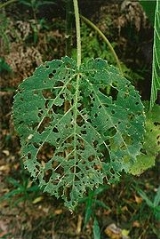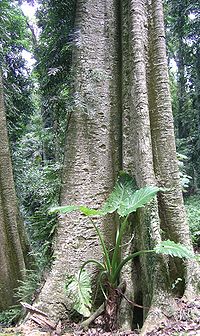
Dendrocnide excelsa
Encyclopedia
Dendrocnide excelsa, the giant stinging tree is a rainforest tree
of eastern Australia
. It occurs from Tathra, New South Wales
to Imbil in south eastern Queensland
, and is very common at Dorrigo National Park
and other rainforest walks in eastern Australia. The habitat of the Giant Stinging Tree is sub tropical, warm temperate or littoral
rainforest, particularly in disturbed areas, previously flattened by storms or cyclones.
.
Minor stings can last for an hour or two. However, severe stinging can last for months. First aid for the sting is to apply wax hair-removal strips and then yank them off to remove the hairs (Hurley, 2000). Dendrocnide stings have been known to kill dogs and horses that have brushed against them. (Hurley, 2000).
Marina Hurley, a leading researcher of stinging trees, found that the only way she could handle the plant to study it was with heavy welding gloves. Seek medical advice if badly affected by the Stinging Tree.
The trunk can be fluted or flanged. The outer bark is grey and smooth, with minor corky markings. The trunk and buttresses are shaped in even curves. The leaves are alternate and toothed. Heart shaped and very large in positions of shade, exceeding 30 cm in length and a similar width. The sun leaves are smaller. The leaves are replete with stinging hairs, and are eaten by various insects and mammals, such as the chrysomelid beetle.
Flowers appear from November to April, forming in short panicles. The fruit is a purple or blackish nut, maturing from March to August. The flesh is edible, but the danger of stinging hairs precludes human consumption. Fruit eaten by many rainforest birds, including the Regent Bowerbird
and Green Catbird
.
used the fibres to make nets and lines.

Tree
A tree is a perennial woody plant. It is most often defined as a woody plant that has many secondary branches supported clear of the ground on a single main stem or trunk with clear apical dominance. A minimum height specification at maturity is cited by some authors, varying from 3 m to...
of eastern Australia
Australia
Australia , officially the Commonwealth of Australia, is a country in the Southern Hemisphere comprising the mainland of the Australian continent, the island of Tasmania, and numerous smaller islands in the Indian and Pacific Oceans. It is the world's sixth-largest country by total area...
. It occurs from Tathra, New South Wales
Tathra, New South Wales
Tathra is a seaside town on the Sapphire Coast found on the South Coast, New South Wales, Australia in Bega Valley Shire. It has a population of 1,622....
to Imbil in south eastern Queensland
Queensland
Queensland is a state of Australia, occupying the north-eastern section of the mainland continent. It is bordered by the Northern Territory, South Australia and New South Wales to the west, south-west and south respectively. To the east, Queensland is bordered by the Coral Sea and Pacific Ocean...
, and is very common at Dorrigo National Park
Dorrigo National Park
Dorrigo National Park is a national park in New South Wales , 580 km north of Sydney on Dome Road off the Waterfall Way, 5 km east of the town of Dorrigo....
and other rainforest walks in eastern Australia. The habitat of the Giant Stinging Tree is sub tropical, warm temperate or littoral
Littoral
The littoral zone is that part of a sea, lake or river that is close to the shore. In coastal environments the littoral zone extends from the high water mark, which is rarely inundated, to shoreline areas that are permanently submerged. It always includes this intertidal zone and is often used to...
rainforest, particularly in disturbed areas, previously flattened by storms or cyclones.
Sting
The hairs of the tree exist on all aerial parts and can cause a severe reaction when in contact with human skin, it is for this reason it is a hazard to livestock, travelers and campers. Even so, the tree is an important member of the ecosystems of eastern Australian forests. The sting is considered more severe than Shining-leaved Stinging Tree, but not as severe as the Gympie StingerDendrocnide moroides
Dendrocnide moroides, also known as the Gympie Gympie, moonlighter, or stinger, is a large shrub native to rainforest areas in northeastern Australia, the Moluccas and Indonesia. It is best known for stinging hairs which cover the whole plant and deliver a potent neurotoxin when touched. It is the...
.
Minor stings can last for an hour or two. However, severe stinging can last for months. First aid for the sting is to apply wax hair-removal strips and then yank them off to remove the hairs (Hurley, 2000). Dendrocnide stings have been known to kill dogs and horses that have brushed against them. (Hurley, 2000).
Marina Hurley, a leading researcher of stinging trees, found that the only way she could handle the plant to study it was with heavy welding gloves. Seek medical advice if badly affected by the Stinging Tree.
Description
A medium to large sized tree with a buttressed base. Sometimes over 40 metres tall and in excess of 4 metres wide at the butt.The trunk can be fluted or flanged. The outer bark is grey and smooth, with minor corky markings. The trunk and buttresses are shaped in even curves. The leaves are alternate and toothed. Heart shaped and very large in positions of shade, exceeding 30 cm in length and a similar width. The sun leaves are smaller. The leaves are replete with stinging hairs, and are eaten by various insects and mammals, such as the chrysomelid beetle.
Flowers appear from November to April, forming in short panicles. The fruit is a purple or blackish nut, maturing from March to August. The flesh is edible, but the danger of stinging hairs precludes human consumption. Fruit eaten by many rainforest birds, including the Regent Bowerbird
Regent Bowerbird
The Regent Bowerbird, Sericulus chrysocephalus is a medium-sized, up to 25 cm long, sexually dimorphic bowerbird. The male bird is black with a golden orange-yellow crown, mantle and black-tipped wing feathers. It has yellow bill, black feet and yellow iris...
and Green Catbird
Green Catbird
The Green Catbird, Ailuroedus crassirostris is a species of bowerbird found on subtropical forests along the east coast of Australia, from southeastern Queensland to southern New South Wales. Its colouring is emerald green, with faint black markings on the face and white streaks on the neck.Green...
.
Uses
Indigenous AustraliansIndigenous Australians
Indigenous Australians are the original inhabitants of the Australian continent and nearby islands. The Aboriginal Indigenous Australians migrated from the Indian continent around 75,000 to 100,000 years ago....
used the fibres to make nets and lines.


